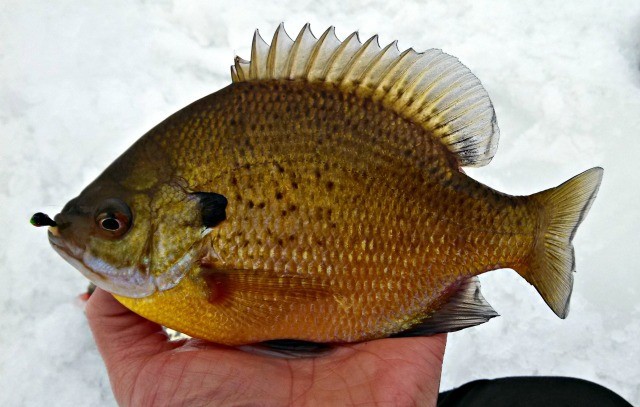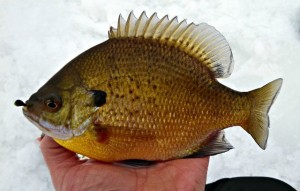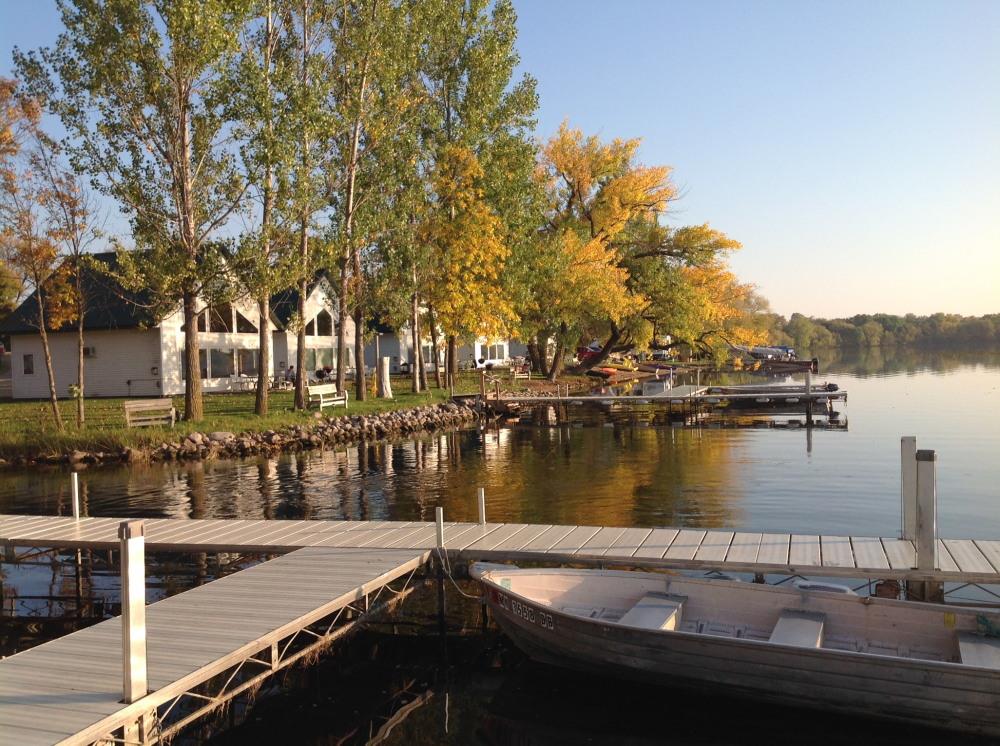Secrets to Catching Bluegill and Crappie in Alexandra!
February 3, 2014 //

The ice conditions across the area are excellent. I’ve been finding anywhere from 24”-30” of ice on average, with vehicle traffic nearly everywhere. The only issue has been the snow and  blowing snow. The bigger lakes such as Osakis, Minnewaska, Miltona, and the Chain of Lakes will most likely have plowed roads. There are also smaller lakes with good plowed roads, but it is more hit and miss. Snowmobiles are an excellent way to get around and allow you to fish away from other anglers, but if that is not an option you can get to plenty of great fishing areas by vehicle. There are people plowing new roads every day, so there always seems to be a lot of options. The fishing across the Alexandria area has been, and continues to be, downright outstanding. We’ve been catching quality northern, walleye, bluegill and crappie on a number of lakes. I’ve also heard good reports from many other lakes I haven’t even had time to fish yet. I write a lot about catching walleye, so I figured I’d dedicate this article to the finer points of catching big panfish during the day. Regardless of how well I feel the fishing is, I still see and hear of anglers struggling to catch quality sunfish and crappie during the day. The most common reason I see people struggling is they use what works for them in the low light time periods, and expect those same tactics and equipment to work during the day, such as using heavy equipment and sitting in one spot. When in reality, the two time periods require very different techniques and equipment. In general, quality fish are finicky by nature. Then, add in the factor of daylight, and these fish become very particular on what they will eat. Even when they do decide to bite it will usually be a very tentative light bite. That’s why the common panfish setup people use (a medium action rod with 4-6 pound test line, #6 or #8 hook, wax worm or minnow and a bobber) will most often not work. These fish can see very well during the day, so that means the bait must move and look as natural as possible for the fish to bite. I recommend a light but sensitive rod with 2 or 3 lb test line for this type of fishing. For a hook I’d recommend a small #12 hook. I prefer a horizontal jig like the #12 Lindy Toad. For bait I also like to keep things small. I usually use 1 or 2 Euro larva on my jig at time. If I use any more than that, or a large wax worm, I feel I start to push away many of the light biting big bluegill.
blowing snow. The bigger lakes such as Osakis, Minnewaska, Miltona, and the Chain of Lakes will most likely have plowed roads. There are also smaller lakes with good plowed roads, but it is more hit and miss. Snowmobiles are an excellent way to get around and allow you to fish away from other anglers, but if that is not an option you can get to plenty of great fishing areas by vehicle. There are people plowing new roads every day, so there always seems to be a lot of options. The fishing across the Alexandria area has been, and continues to be, downright outstanding. We’ve been catching quality northern, walleye, bluegill and crappie on a number of lakes. I’ve also heard good reports from many other lakes I haven’t even had time to fish yet. I write a lot about catching walleye, so I figured I’d dedicate this article to the finer points of catching big panfish during the day. Regardless of how well I feel the fishing is, I still see and hear of anglers struggling to catch quality sunfish and crappie during the day. The most common reason I see people struggling is they use what works for them in the low light time periods, and expect those same tactics and equipment to work during the day, such as using heavy equipment and sitting in one spot. When in reality, the two time periods require very different techniques and equipment. In general, quality fish are finicky by nature. Then, add in the factor of daylight, and these fish become very particular on what they will eat. Even when they do decide to bite it will usually be a very tentative light bite. That’s why the common panfish setup people use (a medium action rod with 4-6 pound test line, #6 or #8 hook, wax worm or minnow and a bobber) will most often not work. These fish can see very well during the day, so that means the bait must move and look as natural as possible for the fish to bite. I recommend a light but sensitive rod with 2 or 3 lb test line for this type of fishing. For a hook I’d recommend a small #12 hook. I prefer a horizontal jig like the #12 Lindy Toad. For bait I also like to keep things small. I usually use 1 or 2 Euro larva on my jig at time. If I use any more than that, or a large wax worm, I feel I start to push away many of the light biting big bluegill.  The jigging technique is a two part operation. The first part is the constant jiggle, and the second is the vertical movement. The majority of people do not realize how fine the jiggle needs to be to make a fish bite. I actually call it more of a wiggle or vibration than a “jiggle”. It has to be extremely light. I almost hold it still at times and let my nerves/heart beat wiggle the tip of the rod. Now that you have the intensity of the wiggle down, let’s talk about the vertical movement in the water column. (Note: everything I’m about to explain is based off the use of a fish locator such as Vexilar, Hummingbird, Marcum. They are all quality units.) I like to start by dropping my lure down through the fish. Then, slowly raise the jig (about an 1/8 inch per second) while you wiggle the jig. It’s important to keep moving the jig up as the fish raises toward your bait. Fish naturally feed up and the continued upward movement makes the fish feel it’s going to get away so they are more apt to bite it. Very commonly they do not bite the bait on the first sequence. There are times I’ve dropped down and jigged up a dozen times to finally get a stubborn giant bluegill to tap my lure. It’s a bit of a game, but it sure is gratifying when you outsmart something so cautious. The last part of this puzzle is to stay on fish. You can do all of the above, but if you don’t move until you find fish, it will be for nothing. I like to start with 15-20 holes in an area I feel will hold fish. Then I’ll check each hole with my locator. If there are two or more suspended fish in a hole I’ll quickly drop my lure down. I’ll fish there as long as I read a good number of fish, but there are many times when I’ll leave a hole with fish to find a hole with even more fish. The more fish you have down a given hole, the more competition there is. This makes the fish think more about missing out on a tasty meal, than why they shouldn’t bite your offering. I see many people get too comfortable and sit on the same couple holes all day catching one here or there. It’s hard for them to move because they’re catching fish. I’m here to tell you, it can be so much better than a couple fish. Grab the family and come explore one of our amazing fisheries! Good luck, and feel free to email me with any questions you might have. Good Luck!Joe Scegura’s Guide Servicewww.jsguideservice.com
The jigging technique is a two part operation. The first part is the constant jiggle, and the second is the vertical movement. The majority of people do not realize how fine the jiggle needs to be to make a fish bite. I actually call it more of a wiggle or vibration than a “jiggle”. It has to be extremely light. I almost hold it still at times and let my nerves/heart beat wiggle the tip of the rod. Now that you have the intensity of the wiggle down, let’s talk about the vertical movement in the water column. (Note: everything I’m about to explain is based off the use of a fish locator such as Vexilar, Hummingbird, Marcum. They are all quality units.) I like to start by dropping my lure down through the fish. Then, slowly raise the jig (about an 1/8 inch per second) while you wiggle the jig. It’s important to keep moving the jig up as the fish raises toward your bait. Fish naturally feed up and the continued upward movement makes the fish feel it’s going to get away so they are more apt to bite it. Very commonly they do not bite the bait on the first sequence. There are times I’ve dropped down and jigged up a dozen times to finally get a stubborn giant bluegill to tap my lure. It’s a bit of a game, but it sure is gratifying when you outsmart something so cautious. The last part of this puzzle is to stay on fish. You can do all of the above, but if you don’t move until you find fish, it will be for nothing. I like to start with 15-20 holes in an area I feel will hold fish. Then I’ll check each hole with my locator. If there are two or more suspended fish in a hole I’ll quickly drop my lure down. I’ll fish there as long as I read a good number of fish, but there are many times when I’ll leave a hole with fish to find a hole with even more fish. The more fish you have down a given hole, the more competition there is. This makes the fish think more about missing out on a tasty meal, than why they shouldn’t bite your offering. I see many people get too comfortable and sit on the same couple holes all day catching one here or there. It’s hard for them to move because they’re catching fish. I’m here to tell you, it can be so much better than a couple fish. Grab the family and come explore one of our amazing fisheries! Good luck, and feel free to email me with any questions you might have. Good Luck!Joe Scegura’s Guide Servicewww.jsguideservice.com
The ice conditions across the area are excellent. I’ve been finding anywhere from 24”-30” of ice on average, with vehicle traffic nearly everywhere. The only issue has been the snow and 

SHARE THIS
ABOUT THE AUTHOR
Posted in Fishing




